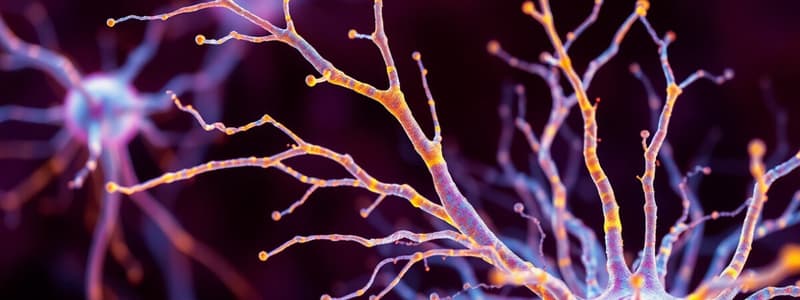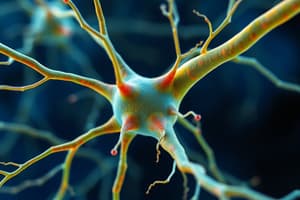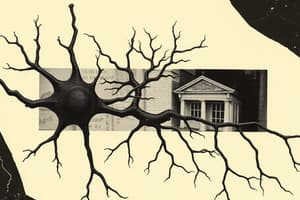Podcast
Questions and Answers
What is the primary function of dendrites in neurons?
What is the primary function of dendrites in neurons?
- Protect the neural cell body
- Facilitate recovery after damage
- Receive information from other neurons (correct)
- Transmit information to other neurons
What type of cell is characterized by having three or more processes?
What type of cell is characterized by having three or more processes?
- Multipolar cells (correct)
- Astrocytes
- Bipolar cells
- Unipolar cells
Which glial cell type is primarily involved in the formation of myelin in the central nervous system?
Which glial cell type is primarily involved in the formation of myelin in the central nervous system?
- Oligodendroglia (correct)
- Neurilemma
- Astroglia
- Microglia
Which structure is an interface between an axon terminal and a dendrite?
Which structure is an interface between an axon terminal and a dendrite?
What happens to dendritic order during learning, according to the information provided?
What happens to dendritic order during learning, according to the information provided?
How many glial cells are estimated to exist in relation to neurons?
How many glial cells are estimated to exist in relation to neurons?
What is the typical width of dendrites in micrometers?
What is the typical width of dendrites in micrometers?
Which of the following statements about unipolar cells is correct?
Which of the following statements about unipolar cells is correct?
What characteristic is common among most axons?
What characteristic is common among most axons?
Flashcards
Neuron
Neuron
The fundamental unit of the nervous system, responsible for transmitting information through electrical and chemical signals.
Cell Body
Cell Body
The main body of a neuron, containing the nucleus and essential cellular machinery.
Dendrites
Dendrites
Branch-like extensions of a neuron that receive signals from other neurons.
Axon
Axon
Signup and view all the flashcards
Myelin
Myelin
Signup and view all the flashcards
Synapse
Synapse
Signup and view all the flashcards
Glial Cells
Glial Cells
Signup and view all the flashcards
Astrocytes
Astrocytes
Signup and view all the flashcards
Oligodendrocytes
Oligodendrocytes
Signup and view all the flashcards
Study Notes
Neurons
- The human cerebral cortex contains approximately 20-25 billion neurons.
- Neuron cell bodies have common shapes like pyramidal and stellate.
- Neuron cell bodies contain cytoplasm, a nucleus, and a nucleolus.
- Dendrites receive information from other neurons.
- Many neurons in the cerebral cortex, thalamus, and hippocampus have dendrites.
- Dendritic growth is associated with learning; individuals with Down's syndrome may have fewer dendritic branches.
- Most neurons have a single axon.
- Axon width typically ranges from 1-4 micrometers.
- Axons contain axoplasm (similar to cytoplasm but without ribosomes).
- Neurotransmitters are usually released from axon terminals.
- Most axons are myelinated (covered in myelin).
- Axons in the peripheral nervous system (PNS) have neurilemma, facilitating recovery after damage.
Neuronal Interfaces
- Gap junctions are characterized by membranes separated by less than 2 nanometers.
- Synapses are interfaces between the axon terminal of one neuron and a dendrite, soma, or axon of another neuron, with a space of approximately 10-15 nanometers.
- Many drugs' chemical structures mimic or interfere with neurotransmitters at synapses. For instance, LSD competes with serotonin.
Neuronal Classification
- Unipolar neurons have one process.
- Bipolar neurons have two processes.
- Multipolar neurons have three or more processes.
Glial Cells
- Glial cells outnumber neurons by approximately 5-10 times.
- Glial cell processes are connected in a vast syncytium, mainly composed of gap junctions.
- Types of glial cells include astroglia, oligodendroglia, and microglia.
Studying That Suits You
Use AI to generate personalized quizzes and flashcards to suit your learning preferences.



